What are the best space games on PC? Featuring the biggest Steam games, like Kerbal Space Program, and the best free games, such as Eve Online, these are the most sensational space epics around.
Trying to pick out the best PC space games is a galaxy-sized question. Developers have been churning out space adventures since the ‘70s, and with everyone getting excited about Jupiter, and with Kickstarter and crowdfunding allowing studios to strike out alone, we’re currently just a teensy bit obsessed with what’s beyond our little blue and green marble.
While we wait for E.T. to return our numerous missed calls, let’s kill the time by playing some amazing intergalactic adventures. Kick Collector ass in Mass Effect 2. Mess around with adorable rocket science in Kerbal Space Program. Stare in awe at the sheer vastness of the universe in Eve Online. If you’re looking to go where only Bill Shatner and chums have boldly gone before, these are the best sci-fi and space games on PC. Just remember… no one will hear you scream.
The best space games are:
- Star Trek Online
- Star Conflict
- No Man’s Sky
- Eve Online
- Stellaris
- Elite Dangerous
- Kerbal Space Program
- Eve Valkyrie
- Endless Space 2
- The Ur-Quan Masters
- Homeworld Remastered Collection
- Master of Orion 1 + 2
- Mass Effect 2
- FTL: Faster Than Light
- Distant Worlds: Universe
- Star Wars: TIE Fighter Special Edition
- Sins of a Solar Empire: Rebellion
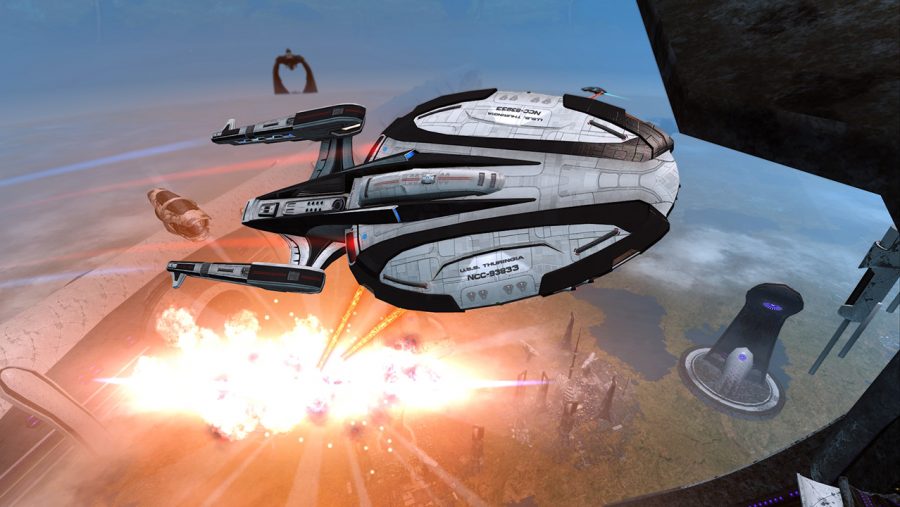
STAR TREK ONLINE
In movies and online, Star Trek has come a long way in a comparatively short space of time, though arguably it’s the initially troubled MMO that’s had the longest journey. Ravaged a little upon release for effectively being a bad fit, Star Trek Online has ended up filling its replica uniform rather well, and is now regarded as one of the best MMORPGs around.
It’s helpful to think of Star Trek Online not just as a game that manages to capture the spirit of the Roddenberry-enforced universe – with its pioneering forays into the unknown, tactical one-on-one battles, and meeting with curious aliens with an abiding love for human history – but as being part of an online fan convention. Players display their affiliations for TOS, TNG, or DS9, indulge their series knowledge and take part in various games on the side, namely via structured away team missions and battles in space. Being a game funded by microtransactions, you can also buy loads of tat, but the point is that Star Trek Online is not so much a sim for gamers who like Star Trek, but a hang-out for Star Trek fans who like to game.
And there’s a lot of game to like, from the way in which you develop your character and bridge officers, to playing through regular episode missions. It’s akin to riding an open-topped shuttle around every nook of Trek lore and history. Where the game excels, however, is during open team space battles, in which small groups of player ships combine to bring down indomitable NPC vessels. With a need to manage shields and power levels, consider speed and positioning, veteran fans of the Starfleet Command games will find much to engage, especially when part of a well-drilled team of frontline and support vessels tearing up the galaxy.
While Star Trek Online came out many, many years ago, it’s still receiving regular content updates and even expansions. The most recent one, Rise of Discovery, tells the story of a pivotal moment in the lives of both Gabriel Lorca and Ellen Landry. You get to experience the events that lead to the first episode of Star Trek: Discovery, plus there’s an overhaul to how you unlock the best ships in the game, making this a much kinder update for new players.
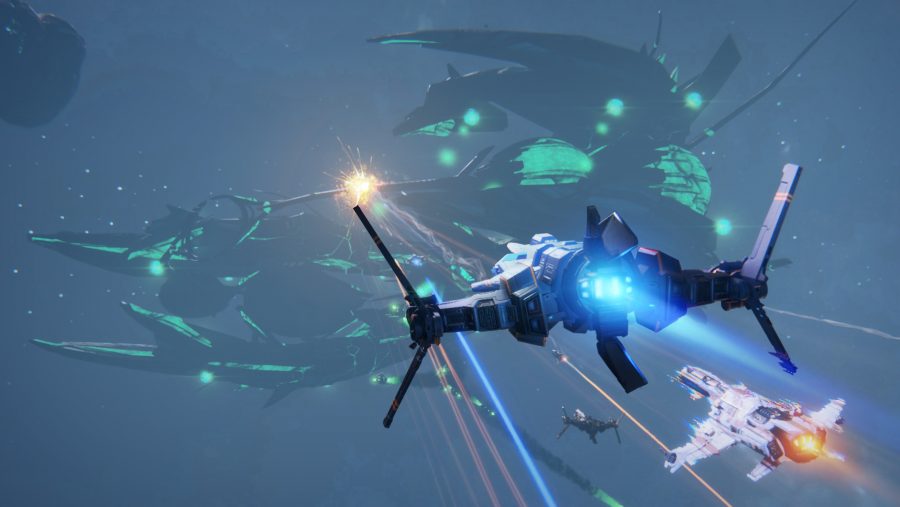
STAR CONFLICT
Star Conflict is a dogfighting free MMO that sees pilots clash amid asteroid belts and above planets in fast-paced scraps. While it’s mostly concerned with PvP battles, you can grab a few quests, explore ruins, and dabble in a spot of crafting.
It’s the ships that make the game, of course. From nimble fighters to beefy frigates and bulky destroyers, there are a copious number of vessels to unlock and upgrade, determining your role in whatever conflict you find yourself duking it out in. There are over a hundred ships to choose from, but getting access to them all takes some doing.
There’s a metagame, too, as you fight for your chosen faction, hunting down foes and getting in pitched battles in an effort to spread your group’s influence and net yourself some lovely rewards.

NO MAN’S SKY
Space is an unconquered and never-ending vista. That desire to explore the unknown also forms the attraction of Hello Games’ No Man’s Sky, which uses procedural generation to ensure that you’ll never reach the end of its recreation of space, which has over 18 quintillion planets to explore.
Exploration isn’t all you’ll do in No Man Sky, however, as you’ll need to find ways to survive. Paramount to your success in doing that is mastering the game’s trading and combat. No Man’s Sky didn’t have the smoothest launch, but a heap of updates has steadied the ship since, adding everything from deep sea exploration to base-building – maintaining a dedicated a loving fanbase that bought a billboard to say thank you.
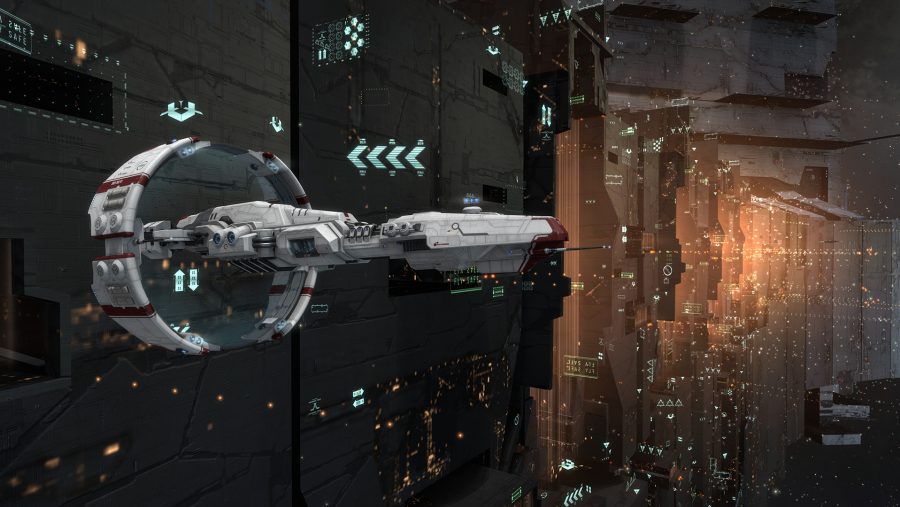
EVE ONLINE
This has been the preeminent space game for so long that you might be forgiven for thinking it’s the only space game in existence. Unquestionably, Eve Online is one of the most interesting, partly down to the fact that its half a million online inhabitants play on the same mega-server rather than having to endure the severed realities offered by its many fantasy contemporaries.
Players join together to form fleets that number in the thousands, and alliances in the tens of thousands, all laying siege to entire regions for months on end, supported by an extensive supply chain of miners, traders, researchers, and manufacturers. In terms of scale and substance, there really isn’t anything else like it. For example, an Eve ship worth 309 billion ISK – one of just one of three in existence – was destroyed by a spy embedded in the ship’s owner’s organisation. Yes, there’s nothing quite like the stories generated by Eve’s astonishing community.
The game is not without its downsides. It has a reputation for being bastard-hard to get into, but after updates to the user interface, graphics and the near-constant streamlining of some of the game’s more obscure systems, the Eve of today is no more difficult to approach than its single-player bosom buddies X and Elite. It’s also receiving regular updates like the recent Eve Online: Onslaught expansion, so you can always look forward to something fresh.
Much more of a concern for the newcomer is how difficult it can be to succeed, especially if your aim is to carve out a small empire for yourself within a few weeks, but you can give yourself a fighting chance with our Eve Online beginner’s guide.

STELLARIS
Stellaris, Paradox’s 4X grand strategy hybrid, makes space surprising again thanks to event chains that are, at first, evocative of Crusader Kings II, but end up going much further. In Stellaris, you should expect mutant uprisings, robotic rebellions, and the discovery of alien texts that make your citizens question their place in the galaxy.
It’s not just a 4X game; it’s a galactic roleplaying game and empire sim, bestowing a vast array of options upon players, allowing them to create unique, eccentric, space-faring species. You can play as a fundamentalist society built on the backs of slaves, or hyper-intelligent lizards that rely on robots whether they are fighting or farming. The robust species creator and a multitude of meaningful decisions mean that you can create almost any aliens that you can imagine.
And underpinning all of that is the game’s focus on exploration. While most space 4X games stick with one method of interstellar travel, Stellaris gives you three to choose from, each with their own strengths and counters. In one game, the galaxy might be a network of hyperlanes, but in the next, you might find yourself building wormhole stations and blinking across the galaxy.
Stellaris’ multiplayer isn’t to be overlooked either, transforming decent human beings into Machiavellian alien tyrants at the drop of a hat.

ELITE DANGEROUS
30 years since it first graced the BBC Micro, the Elite series returns in the form of Elite Dangerous. It’s been around for a while in alpha and beta forms, enough time to be written about thousands of times and played by countless pirates, bounty hunters, traders, and explorers. So we already knew it was going to be a bit impressive.
Our playground is a whole galaxy. Not just any galaxy, either. The Milky Way is the setting of Elite Dangerous, built to terrifying scale. It’s a galaxy populated with black holes, gargantuan suns, space anomalies, and spaceships that flit around like tiny specks of dust on an inconceivably big table. It’s still familiar and authentically Elite, but elevated by tech that would have boggled minds in 1984, when 256 planets was massively impressive. How you carve out a life in this galaxy is much the same, though, whether you become a trader, filling your cargo hold with algae and microchips, or a mercenary, fighting in an interstellar war.
It’s great, and thanks to Elite Dangerous mods, players are improving it with things like chatting ship AIs that react to voice commands. Frontier also continues to fatten it up with free updates along with the Elite: Dangerous’ Horizon expansion. And if you’re lucky enough to have an Oculus Rift, then you’re in for a treat, right up to the point where your ship spins out of control and you dive head-first into a sick bag.
If that’s got you excited to strap into a Cobra and hurtle into the inky black, get your space adventure started with our Elite: Dangerous guide.
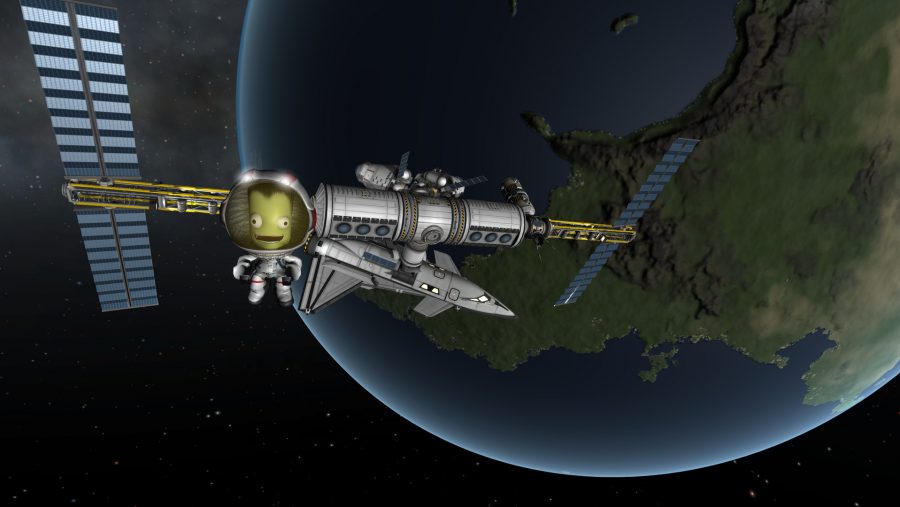
KERBAL SPACE PROGRAM
The first order of doing anything in space is, of course, to get there. Unfortunately, most games in this otherwise splendid list make the rather wild assumption that rocket science isn’t all that important and skip to the business of spreading violence, free market capitalism, and all manner of other human diseases to all corners of various galaxies. Thankfully, the space program to which the Kerbals fatefully apply is rather more grounded in reality, in the sense that the aim of the game is to avoid crashing into the stuff.
Kerbal Space Program is ostensibly about trial and error, first in building a vessel capable of getting its payload off the ground, which is relatively easy, second by actually getting the damn thing launched and steered into some kind of orbit. You soon realise that getting past the Karman Line is one thing, while delivering your payload safely to its destination another entirely. Thankfully, because your gurning passengers seem quite happy to be sacrificed for the greater good of the basic understanding of astrophysics, the trial and error is every bit as involved and entertaining as any fleeting success.
As you’ll read in our Kerbal Space Program PC review, there’s plenty of successes to aim for: reaching the Mun (nee Moon), deploying a modular space station, and mining on distant planets are all attainable, albeit after a great deal of crushing but entertaining failure, made bearable thanks to a combination of hard science unpinning a soft and cute interior. As well as being a bloody good space game, KSP may well be the most entertaining community-enriched sandbox games since Minecraft – massively helped along by Kerbal Space Program mods.
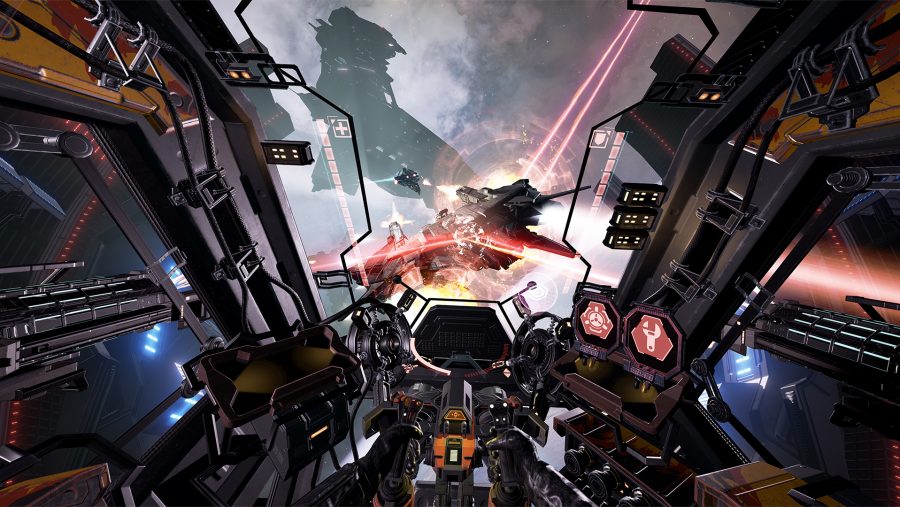
EVE VALKYRIE
There are a lot of pretty cockpits in VR, but Eve creators CCP did it best when they hired Mirror’s Edge producer Owen O’Brien to head up their scrappy space dogfighting simulation game.
Like the parkour cult classic, Eve Valkyrie is lent unparalleled first-person immersion through a hundred tiny touches in animation, art, and sound design – from the way your ship tips forward as it accelerates out of the hangar, through the sight of your arms at the control panel, to the muffled roar of your thrusters.
What Valkyrie captures that other space games don’t is scale – the sense that you’re piloting a rubber duck in a bath owned by Eve giants like the Amarr Titan. It’s impossible not to become acutely aware that you’re only a cracked windscreen away from a cold and unforgiving void, with just your manoeuvrability saving you from the ferocious and unyielding fire of enemy players. It’s no surprise Valkyrie is one of the best VR games on PC.
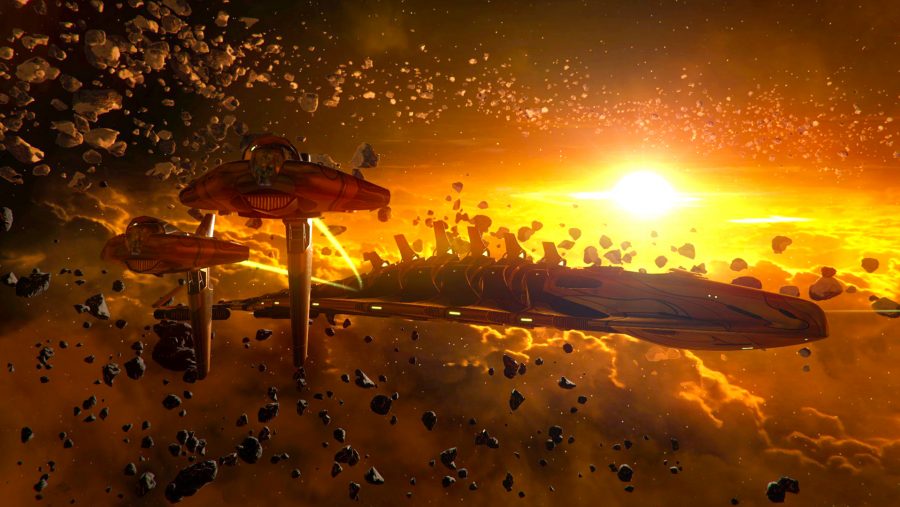
ENDLESS SPACE 2
Story, a 4X designer would probably say, is something that emerges naturally from the interplay of systems in a strategy game – the clash of borders, an unplanned war. Amplitude Studios don’t think that’s much of an excuse. They’ve stuffed Endless Space 2 with as much science fiction as it can contain – and given that it’s got whole galaxies to fill, that’s plenty.
Here you’ll meet living crystals, tiny dragons, recycled war machines and millions of clones of a bloke named Horatio. It’s a universe teeming with offbeat ideas to enjoy, and then enslave, if you’re that sort of explorer. If not, you can play as a bunch of sentient trees and spread olive branches throughout known space.
There’s less left to the imagination than in conventional grand strategy – scraps are resolved in a beautiful 3D battle engine that sees your elaborate ships drift together in the void in a dramatic, interplanetary ballet. It’s like Football Manager, but with chrome, faster-than-light monoliths. Isn’t that what Sega’s catalogue has been missing until now? If you still need convincing then just read our glowing Endless Space 2 review.

THE UR-QUAN MASTERS
Here a quick sell for The Ur-Quan Masters: it’s not only free, it’s also one of the best free PC games you’ll ever find.
Played from a top-down perspective, UQM is a hitchhiker’s’ fight for the galaxy in a game of exploration, diplomacy, role-playing, and combat. You play the commander of a lost research mission sent to re-establish contact with Earth. However, upon reaching the Sol system you soon discover the third planet has been conquered by the unpleasant Ur-Quan. Without the means to free the planet’s inhabitants or oppose its oppressors, your quest is then to head out to distant worlds and find the resources, allies, and clues to help overcome the three-eyed tentacle-beasts that hold humanity in bondage.
While UQM’s flight model isn’t much more evolved than a game of Asteroids, the extensive galaxy, populated by hundreds of planets, stars and moons – all of which can be scanned, visited, and plundered – making for a deeply involving game. Constantly having to land on planets and collect materials to trade can get a little tedious, but discovering ancient secrets and conversing with the game’s 18 unique and often hilarious races (20 if you separate the Zoq from the Fot and Pik) more than makes up for having to constantly take in so many identikit planets. If meeting the cowardly Captain Fwiffo doesn’t make you immediately fall in love with the game then you’re probably dead inside.

HOMEWORLD REMASTERED COLLECTION
Homeworld’s the sort of game that gets inside your head and just stays there. It originally came out 15 years ago, eventually spawning an expansion, an excellent sequel, and most recently, Homeworld Remastered Collection. It’s a series that remains unsurpassed. It’s also one of those rare strategy games that has a great story; both tragic and hopeful, filled to the brim with tension. It’s a voyage of discovery, of learning about the past and desperately struggling to create a future. It’s beautiful and a bit sad.
Thanks to Gearbox’s Homeworld remastering efforts, one of the best old games is even more beautiful. Now the game looks like it does in our memories, even those clouded by nostalgia, with its beautifully detailed ships and its gargantuan space backdrops. And, thanks to its minimalist UI, none of that beauty is obscured.
Watching the game in action is like viewing an epic ballet. Tiny ships fly in formation in all directions; massive, heavily armed capital ships float around the vast mother ship; diligent resource gatherers work away to fuel a massive undertaking. Even the biggest vessels are dwarfed by the size of the 3D maps, and when the camera is zoomed out, they look alone and vulnerable. Which is exactly what they are.
MASTER OF ORION 1 + 2
Fans have been arguing since last century over which of the Master of Orion games is the better of the series and they only seem to agree that the third most definitely isn’t it, which makes the widely-available double pack featuring the first two MOOs something of an essential and stress-free purchase – at least until Wargaming finish their MOO reboot with the help of some “key members” of the original team.
Released in 1993, Master of Orion took the concepts of Sid Meier’s classic turn-based Civilization and applied it across a galaxy of planets rather than one, so that instead of various flavours of human settlers and terrestrial biomes, players were given a wide range of planet types and races to control and conquer, such as the Silicoids; able to thrive in the most hostile of environments, albeit at a glacial reproductive rate.
While the driving force behind Master of Orion and all of the best strategy games since has been technological advancement and colonialism, this was the first game of its type to really nail diplomacy and offer a route to victory in which some measure of galactic peace could be achieved. The sequel went even further, with customisable races and a political victory that required you to be elected as the Supreme Leader of the galaxy.
What is undeniable is that MOO I and II are important historical references, as seminal an influence on turn-based space conquest as the first two Doom games were establishing and defining the FPS. Unlike Doom, however, MOO has cast such a long monolith-shaped shadow over the entire space game genre that many would argue that the Orion games have yet to be eclipsed.
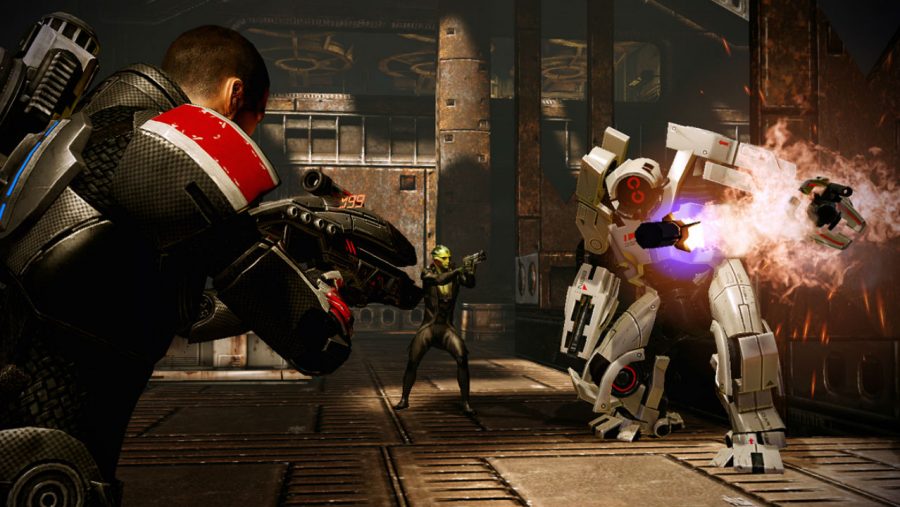
MASS EFFECT 2
Admittedly, there’s not much fizzing and fwooshing of spaceships to be enjoyed in Mass Effect, but it’s still a planet-hopping, alien-seducing space adventure, and one of the best sci-fi RPGs you’re likely to play.
Mass Effect 2 merits inclusion here for two reasons: one is the obvious strength of the story and the characters, a story that started strong in the first game and blossomed throughout its middle act to such a degree that the conclusion was always going to wilt a little. Secondly, in spite of a complete lack of direct spaceship control, you felt not just part of a crew, but in command of a functioning ship with an ability to explore the galaxy.
Parallels have been drawn – not least by Bioware themselves – between the Mass Effect trilogy and the classic exploration series Starflight, which was notable in the late 1980s for being one of the very first space exploration games and is notable today for not having been bettered in that regard since. In terms of storyline, with all that ancient technology end-of-the-world-as-we-know-it gubbins, Mass Effect’s storyline is remarkably close to Starflight’s. Indeed Starflight could almost be seen as the ’70s original to Mass Effect’s BSG-style gritty reimagining, only without the risible Galactica 80 spin-off series to besmirch its reputation.
In case you’re wondering why any of the series’ newer entries aren’t here, read our rankings of the best Mass Effect games.
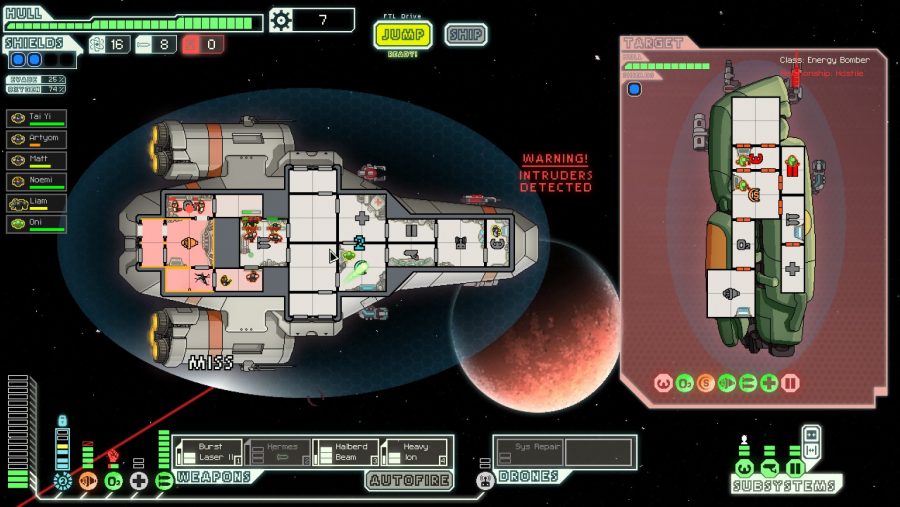
FTL: FASTER THAN LIGHT
Space is awful and will probably kill you: that’s the lesson FTL attempts to impart on brave spacefarers. The permadeath ship management game is, on the surface, a simple race to deliver information to the hands of your allies, but you’re being chased. With every diversion explored, the enemy fleet gets closer and closer, and even if you do stay ahead of them, random death lurks around every corner.
Random violent encounters, shopping sprees, new worlds and races, unlockable ships and configurations, loads and loads of weird and wonderful weapons and tools – there’s so much in FTL that every game has the potential to be dramatically different. One could see you managing a tough vessel that employs ion cannons to disable enemy systems and drones to pepper them with lasers. Another might inspire you to use mind control to defeat your enemies, or teleporters to fill their ships with your own crew.
So much can go wrong. Sometimes it’s your fault, like when you mess up a fight and end up rapidly attempting to patch up hull breaches and put out fires. But sometimes luck just isn’t on your side, like when you agree to help a space station deal with a plague and one of your crew gets sick. But every failed attempt is a complete story full of adventures and misadventures, and a great excuse to make another valiant attempt.

DISTANT WORLDS: UNIVERSE
Another 4X game to add to the list, but really, Distant Worlds is whatever you want it to be, and we were rather taken with it in our Distant Worlds: Universe review. It’s an exploration game where you have one vessel that’s part of a massive empire, and you spend the whole time flitting around the galaxy. A trade game, where one eye is always on your bank account, while the other is hungrily looking at aliens, searching for good deals and diplomatic opportunities. A game where you are the master of everything, sticking your finger in every conceivable pie, from military matters to colonisation.
It’s huge; mind-bogglingly, overwhelmingly massive. An entire galaxy is simulated from private traders going about their business, to pirates getting up to no good. It’s the most ambitious 4X space game that you’re ever likely to find.
At its core, it’s a tool for creating your own galaxies to play in. Players can curate the game to such a degree that one game could bear no resemblance to the next. Everything from the age of the galaxy to the aggression of pirates can be dictated before a game even begins.
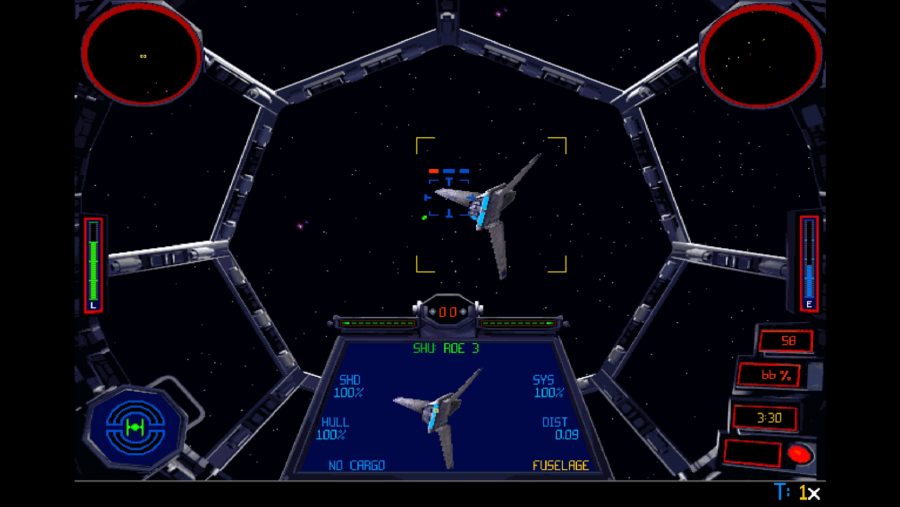
STAR WARS: TIE FIGHTER SPECIAL EDITION
LucasArts might be gone, and one could argue that it died long before it officially shut down, but we’ll always have reminders of what it once was, with brilliant games like Totally Studio’s phenomenal Star Wars: TIE Fighter, the villainous sequel to X-Wing.
Its predecessor was great, there’s no doubt about it, but TIE Fighter’s campaign lets you play as an Imperial, and the Devil is always more fun. It was also, across the board, an improvement over X-Wing, from its graphics – now very dated, admittedly – to a targeting upgrade that allowed pilots to focus on specific parts of an enemy capital ship or station.
This isn’t some arcade space shooter like its not-quite-successor, the Rogue Squadron series. This is a space sim first, which comes with greater complexity but also greater control. For instance, if you’re being battered by laser fire from a pesky X-Wing and your ship’s been damaged, then you assign the order in which systems are repaired, allowing you to prioritise so you can survive for a few more seconds. Just enough to win the fight.
Being an oldie, expect a wee bit of fiddling to get the best experience. Thankfully, we’ve got a Star Wars: TIE Fighter beginner’s guide, which should save you from some potential problems.
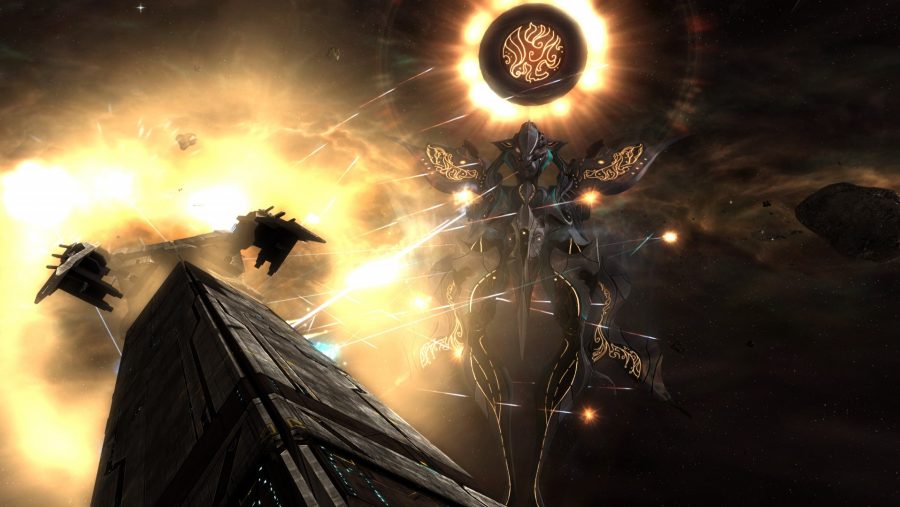
SINS OF A SOLAR EMPIRE: REBELLION
A game that successfully manages to combine the very best of 3D real-time strategy – albeit without a proper single-player campaign – with the kind of empire building offered only by the very top 4X games.
Sins of Solar Empire: Rebellion is played across a user-defined network of stars. Players begin forging an empire around the gravity wells of planets with shipyards, research outposts, extractors, and defence systems, then assemble fleets combining frigates, corvettes, cruisers, and capital ships to map and eventually conquer neighbouring systems.
In earlier versions of Sins of a Solar Empire, conquest was largely achieved in the time-honoured RTS fashion of dragging a huge box around every single damn ship you owned and directing them towards the enemy systems so as to allow sheer force of numbers to win the day. However, with the introduction of diplomatic victories in a previous expansion and research and occupation victories as part of 2012’s Rebellion standalone – not to mention new Death Star-like titan ships as a much-needed counter to the ultra-defensive starbases structures – the stalemates that would often cause games to peter out can be pursued as potentially winning strategies. And let’s not forget about the mods that let you play out your Star Wars or Battlestar Galactica fantasies.
That’s our pick of the best space games on PC. While we have you, why not check out some of the most exciting upcoming PC games, or if you’re in the mood to read about the absolute greatest titles of all-time, check out our list of the best PC games. In the meantime, lose yourself in the space epics above. Hopefully, by the time you’re done playing them, that bloody rude E.T. will have finally checked his voicemail.
